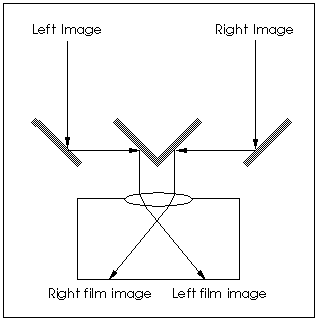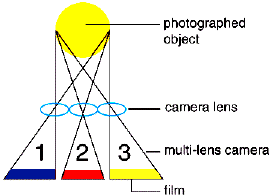Stereo Photography
Contents
Introduction
The lenticular method
Stereo Base Calculator
Beam splitters
Links
Stereo photography may be described as the process of taking two or more simultaneous photographs from
locations separated horizontally such that the photographs may be viewed separately by the two eyes where they
are combined to produced a three dimensional perception of the original scene.
Four basic methods are used for taking stereo photos today:
 a single camera which takes two pictures through two lenses,
a single camera which takes two pictures through two lenses,
 a single camera with a mirror arrangement (beam splitter) mounted to the single lens which
puts two side by side images on one photo frame,
a single camera with a mirror arrangement (beam splitter) mounted to the single lens which
puts two side by side images on one photo frame,
 two side by side mounted cameras, and
two side by side mounted cameras, and
 a single camera which takes three or four simultaneous photos.
a single camera which takes three or four simultaneous photos.
The first three produce the "traditional" 3D-photo images which require (for most people) special projectors
and/or viewers to recreate the 3D-image. The fourth, "modern", method is used with a photo printing process
that places the images under a lenticular surface in such a way that each eye sees a slightly different view of the
subject.
The lenticular method offers an alternative to holograms. Lenticular 3-D cameras assemble multiple (usually three
of four) images of objects from different perspectives through multiple lenses. This creates the left eye and right
eye views necessary to simulate "parallax" - the apparent difference in position of an object when it is seen from
two viewpoints.
When the shutter is clicked, each of the camera lenses exposes a section of standard 35mm color print film.
During processing, the illusion of 3D is created by printing the left and right eye views on a lenticular print
material. The lenticular print material has a series of ridges or lenses on its surface. The image is optically "sliced"
so that a thin strip of each image lies under each small lens, in precise alignment. The lenticular screen allows the
left eye to see only left eye views, and the right eye to see only right eye views. The brain then merges these two
views into a single 3D image using a process called stereopsis.

Lenticular print machine copied from Kodak.
A software tool is available to assist with base-line calculations for stereo photography.
A beamsplitter involves a system of mirrors and/or prisms which fit in front of the normal lens of an SLR, and
"split" the
film into a left and right version. A model using mirrors operates like this:

Image copied from Rocky Mountain memories.
Currently manufactured beamsplitters includes the Ukrainian-made SKF-1 beamsplitter, the Franka beamsplitter,
and the Pentax beamsplitter. In most cases, the beamsplitter itself is used with an attachment as a slide viewer.
The images may also be free-viewed. Beamsplitters generally introduce vignetting around the image frames, and
are sensitive to the f/stop used. The more wide-open the lens (numerically smaller f/stop), the less this is a
problem. But those lens settings work against good 3D, in which you generally want to have as much
depth-of-field as possible. In particular, the center band between the two photos gets larger as the camera lens is
stopped down. As a rule of thumb, generally f/stops should be kept at f/8 - f/5.6 or more; going down to f/11 will
generally give unacceptable results.
Pros and Cons of beamsplitters
Beamsplitters have strengths and weaknesses. Some of these are:
Advantages:
 Depending on the unit, can be considerably lower cost than a dedicated 3D camera. Some units actually cost
more than a dedicated 3D camera, however.
Depending on the unit, can be considerably lower cost than a dedicated 3D camera. Some units actually cost
more than a dedicated 3D camera, however.
 You can use your existing SLR with all it's features (i.e autofocus, autoexposure, faster shutter speeds than
'50s 3D cameras, etc.)
You can use your existing SLR with all it's features (i.e autofocus, autoexposure, faster shutter speeds than
'50s 3D cameras, etc.)
 Stereo alignment is automatic - no need to cut and mount slides or worry about the stereo window.
Stereo alignment is automatic - no need to cut and mount slides or worry about the stereo window.
Drawbacks:
 The dark band between the two images may fool auto-exposure systems.
The dark band between the two images may fool auto-exposure systems.
 Beamsplitters introduce keystone distortion because the outer mirrors are not exactly at a 45 degree angle.
This is not a problem when the beamsplitter itself is used as a viewer, but can be if, for example, a print is made
and viewed by free-viewing. Many users do not find this objectionable, but you might.
Beamsplitters introduce keystone distortion because the outer mirrors are not exactly at a 45 degree angle.
This is not a problem when the beamsplitter itself is used as a viewer, but can be if, for example, a print is made
and viewed by free-viewing. Many users do not find this objectionable, but you might.
 It is important to keep the beamsplitter level with the camera. Some models stay in place better than others.
It is important to keep the beamsplitter level with the camera. Some models stay in place better than others.
 If the front element of your SLR lens rotates as focus is adjusted, a beamsplitter may be a lot of trouble to use.
If the front element of your SLR lens rotates as focus is adjusted, a beamsplitter may be a lot of trouble to use.
 The "tall thin" format of most beamsplitters can be compositionally challenging.
The "tall thin" format of most beamsplitters can be compositionally challenging.
Some excellent examples showing the effects of f/stop and beamsplitter keystoning can be found at Rocky
Mountain memories.
Beam spreaders
A beamsplitter (such as is used in the Loreo camera) is a similar concept, but replaces the single lens in a
beamsplitter with two lenses. This has the effect of "spreading" out the stereo base. For example, the Loreo
camera uses two small lenses
which each take a half-frame image (i.e each one exposes half of a 24x36mm film frame, for two 18x24
side-by-side
images). Without a beamspreader, this would result in a stereo image with a stereo base (lens separation) of
18mm. The
beam spreader mirror arrangement simply widens out the stereo base to a more normal value (i.e. 65mm).
- 3D Image Technology: Producer of Modern (Lenticular) 3D Photo Equipment
- Reel 3D: US Largest Mail Order Selection of New 3-D Supplies.
- Rocky Mountain Memories: Equipment and Supplies for the 3D Photographer.
- 3-D photography for the DIY enthusiast
- Stereo photography resource links.
- Ray Hannisian's Page Ray's home page has many stereo images suitable for free-viewing
- Mark's Stereo Page
- Juggling in Three Dimensions at the St. Louis Festival
- Large format photography including 3-D.
- Modern 3-D photography Harry McDonald's experiences with lenticular 3D photography
- Stereo Photography. Book giving, useful formulas, tables, calculations, DIY.
- Realist 3.5 Stereo Camera A 3-D camera
- Kodak Stereo A 3-D camera
- Loreo Camera A 3-D camera
- Nimslo 3D A 3-D camera
- RBT 3DX2 A 3-D camera
- Revere Stereo 33 A 3-D camera
- TDC Stereo Colorist A 3-D camera
- Viewmaster Personal A 3-D camera
- Viewmaster Mk II A 3-D camera
- Stereo Lomo A 3-D camera
- Stereo Mac A 3-D camera
- 3D Magic A 3-D camera.
- 3D Magic plus A 3-D camera.
- 3D Wizard A 3-D camera.
- 3D 1000 A 3-D camera.
Copyright © 1996 The Turing Institute. All rights reserved.
Revised: July 29th, 1996
![]() a single camera which takes two pictures through two lenses,
a single camera which takes two pictures through two lenses,![]() a single camera with a mirror arrangement (beam splitter) mounted to the single lens which
puts two side by side images on one photo frame,
a single camera with a mirror arrangement (beam splitter) mounted to the single lens which
puts two side by side images on one photo frame,![]() two side by side mounted cameras, and
two side by side mounted cameras, and![]() a single camera which takes three or four simultaneous photos.
a single camera which takes three or four simultaneous photos.


